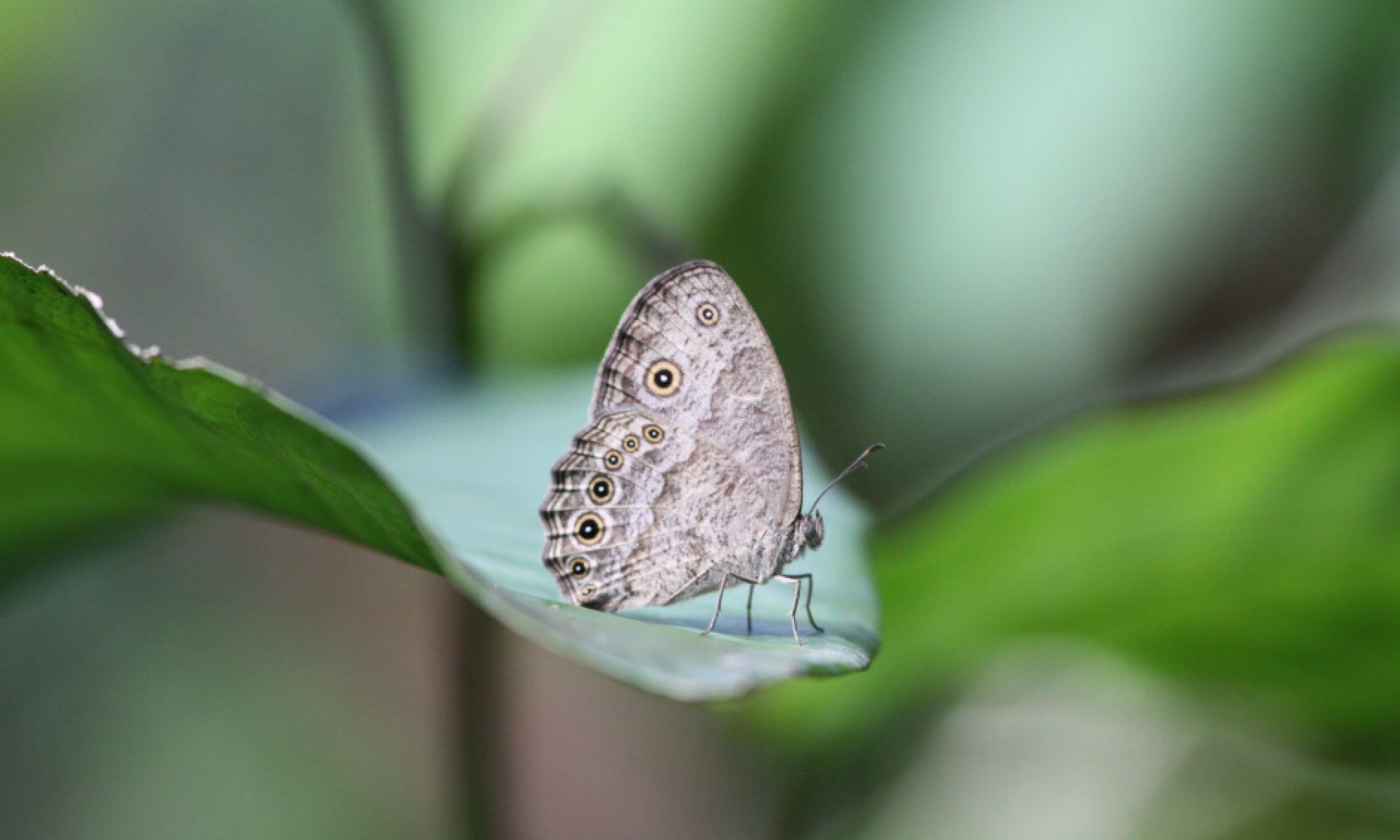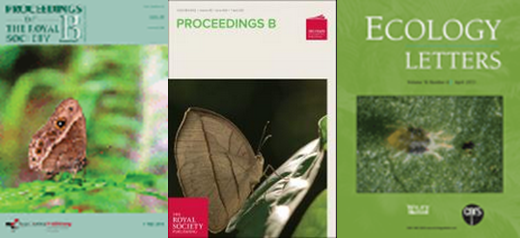
Submitted
More to come…. patience!
2023
Marcantonio M, Voda R, Da Re D, Igot Q, Dennis RLH, Vielfaure A, Vanwambeke S, Nieberding CM (2023) The Effect of Habitat on Insect Movements: Experimental Evidence from Wild-Caught Butterflies. Insects 14: 737. PDF
Braem S, Crucifix M, Nieberding CM, Van Dyck H (2023) Microclimatic buffering in forest, agricultural, and urban landscapes through the lens of a grass‐feeding insect. Ecosphere 14: e4611. PDF
Visser B*, Le Lann C*, Hahn DA, Lammers M, Nieberding CM, Enriquez T, Scheifler M, Harvey JA & Ellers J (2023) Many parasitoids lack adult fat accumulation, despite fatty acid synthesis: A discussion of concepts and considerations for future research. Current Research in Insect Science: 100055. *co-first authors. PDF
2022
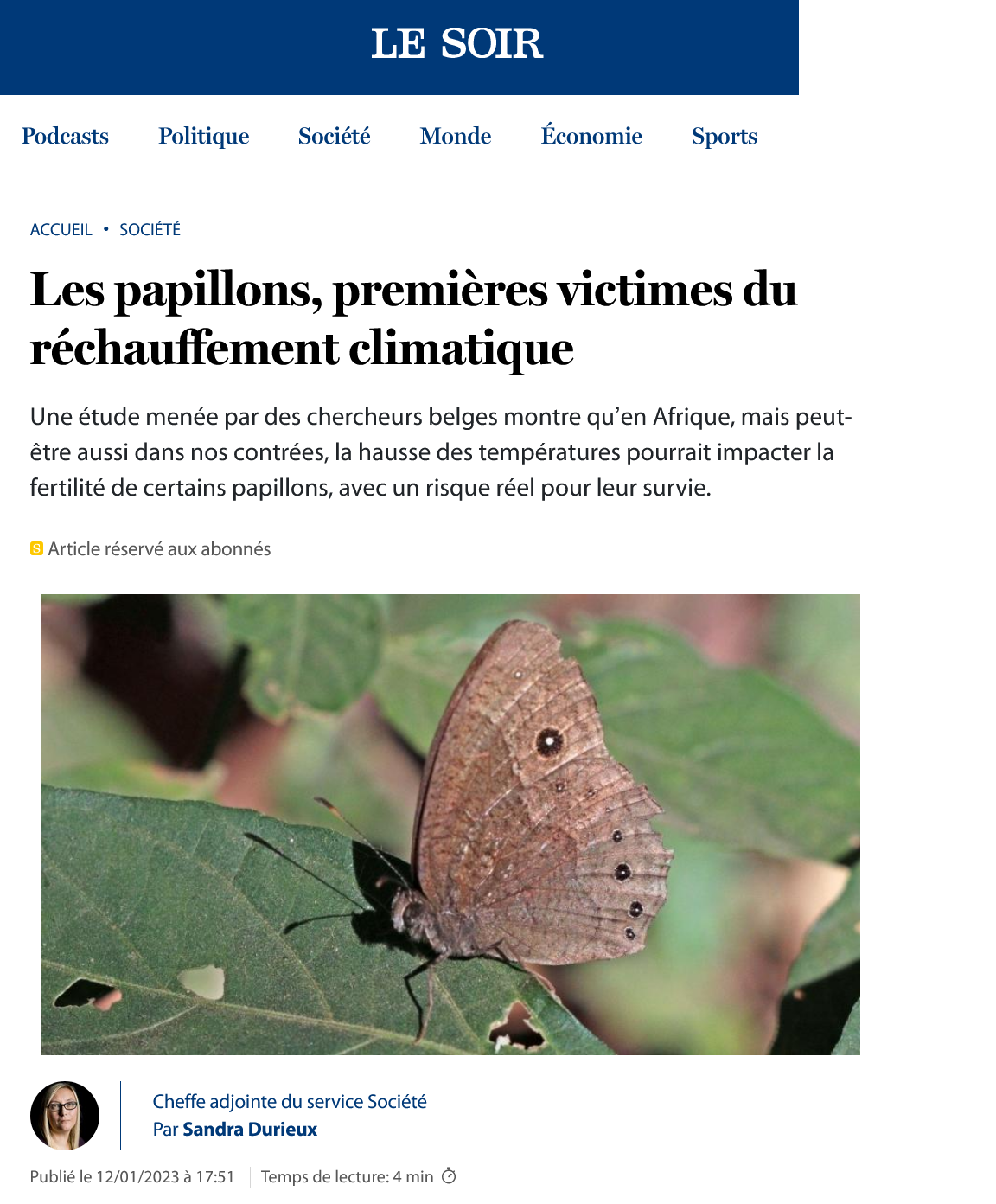
Holveck M-J*, Muller D*, Visser B, Timmermans A, Colonval L, Jan F, Crucifix M & Nieberding CM (2022). Warmer temperatures result in maladaptive learning of sexual preferences. *Co-first authors. Functional Ecology 37: 358-371. PDF.
Nieberding CM, Beldade P, Baumlé V, San Martin G, Arun A, Lognay G, Montagné N, Bastin-Héline L, Jacquin-Joly E, Noirot C, Klopp C & Visser B (2022). Mosaic evolution of molecular pathways for sex pheromone communication in a butterfly. Genes, In Press. PDF.
Enriquez T, Lievens V, Nieberding CM & Visser B (2022) Pupal size as a proxy for lipid content in lab-reared and field-collected Drosophila species. Scientific Reports, In Press. PDF.
Nieberding CM (2022) Pandémie COVID-19 et crise de biodiversité : causes, conséquences et transition vers une coexistence durable entre humains et écosystèmes naturels. Article de synthèse invité par Unesco Belgique, en français, sous presse. Manuscrit disponible (tous droits réservés)
Nieberding CM, Kaiser A, Visser B (2022) Inbreeding and learning affect fitness and colonization of new host plants, a behavioral innovation in the spider mite Tetranychus urticae. Entomologia generalis, In press. PDF.
2021
Nieberding CM, Marcantonio M, Voda R, Enriquez T and Visser B (2021) The evolutionary relevance of social learning and transmission in non-social arthropods with a focus on oviposition-related behaviors. Genes 12, 1466. PDF
Braem S, Turlure C, Nieberding CM, Van Dyck H (2021) Oviposition site selection and learning in a butterfly under niche expansion: an experimental test. Animal Behaviour 180: 101e110. PDF
Visser B, Alborn HT, Rondeaux S, Haillot M, Rebar D, Hance T, Riederer JM, Tiso S, Eldijk TJB, Weissing FJ & Nieberding CM (2021) Phenotypic plasticity explains apparent reverse evolution of fat synthesis in parasitic wasps. Scientific Reports 11: 7751. PDF
2020

This pretty well sums up 2020….
2019
Muller D, Elias B, Collard L, Pels C, Holveck MJ & Nieberding CM (2019) Visual and chemical secondary sexual wing traits of across seasonal forms in the polyphenic butterfly Bicyclus anynana: how different are intermediate forms? PLoS ONE
14(11):e0225003. PDF
We characterize two male secondary sexual traits in individuals that emerge during the seasonal transition in the wild and called “intermediate”.
Dion E, Monteiro A, & Nieberding CM (2019) The role of learning on insect and spider sexual behaviors, sexual trait evolution and speciation. Invited review in Frontiers Ecology and Evolution 6:225. PDF
We show that most insects studied to date show extensive learning ability to choose among available mating partners, and this can affect the evolution of sexual traits, of mating preferences and affect speciation. This is a change of paradigm that occurred within the last decade: insects are not miniature robots that behave only based on their “instinct”.
2018
Nieberding CM, San Martin G, Saenko S, Allen CE, Brakefield PM & Visser B. Sexual selection contributes to partial restoration of phenotypic robustness in a butterfly. Scientific reports 8:14315. PDF
This is the first evidence that phenotypes of individuals forming a species remain sufficiently similar to define a “species” thanks to the expression of sexual preferences in females.
Visser B, Dublon I, Heuskin S, Laval F, Bacquet PM, Lognay G & Nieberding CM. Common practice tissue extraction in solvent does not reflect actual emission of a sex pheromone during courtship in a butterfly. Frontiers Ecology and Evolution 6: 154. PDF
A problematic finding : using the usual method to quantify chemicals forming, for example, the sex pheromone of insects leads to a very different picture than what individuals actually smell from each other emissions. Thus, liquid extractions of chemical from insect tissue should be taken with a pinch of salt.
Visser B, Hance T, Noël C, Pels C, Kimura MT, Stökl J, Geuverink E & Nieberding CM.V ariation in lipid synthesis, but genetic homogeneity, among Leptopilina parasitic wasp populations. Ecology and Evolution 8:7355–7364. PDF
These insects have the amazing property to survive despite their inability to produce lipids, the energy storage system common to all living organisms. We start unravelling how this is possible here. Curious? Check out Visser et al submitted manuscript to PCI Evol Biol.
Nieberding CM, Van Dyck H & Chittka L. Adaptive learning in non-social insects: from theory to field work, and back. Invited review in Current Opinion in Insect Science 27: 75-81. PDF.
A change of paradigm occurred in the last decade: insects are not miniature robots that behave only based on their “instinct”.Most insects studied to date show extensive learning ability and we focus on field-based evidence to track the adaptive value of learning in nature. Curious ? Check out our other review in learning ability of insects in relation to sex in Dion et al (2019) Frontiers Ecol Evol.
Nieberding CM & Visser B. Incestuous insects in nature despite occasional fitness costs. Peer Community in Evolutionary Biology. doi: 10.24072/pci.evolbiol.100047. PDF
We support this amazing initiative of Peer Community In that provides excellent peer review, free of cost and open access top quality science for a better access of knwoledge worldwide.
Nieberding CM & Holveck MJ. Unnatural experimental conditions inflate the importance of male courtship activity on mating success in a butterfly. Commentary on Kehl et al.“Young male mating success is associated with sperm number but not with male sex pheromone titres”. Frontiers in Zoology 15:18. PDF.
Our key message is here is to provide the experimental conditions to let female sexual preferences be expressed in the model butterfly B. anynana and avoid to quantify rape instead.
2017
Nieberding CM & van Alphen JM. Culture in Bumblebees. Peer Community in Evolutionary Biology. doi: 10.24072/pci.evolbiol.100001. PDF
We support this amazing initiative of Peer Community In that provides excellent peer review, free of cost and open access top quality science for a better access of knwoledge worldwide.
Nieberding CM & Holveck MJ. Laboratory social environment biases mating outcome: a first quantitative synthesis in a butterfly. Behavioral Ecology and Sociobiology 71: 117. PDF.
Our key finding here is: if you wish to quantify female sexual preference, better is to design experimental conditions to let it be expressed. Otherwise, this is called rape.Check also Holveck et al (2015) An Beh from our lab to know more.
2016
Bacquet PMB, De Jong M, Brattström O, Wang HL, Molleman F, Heuskin S, Lognay G, Löfstedt C, Brakefield PM, Vanderpoorten A & Nieberding CM. Differentiation in putative male sex pheromone components across and within populations of the African butterfly Bicyclus anynana as a potential driver of reproductive isolation. Ecology and Evolution: 6064-6084. PDF.
Chemicals on male wings in field-caught African populations of butterflies diverge before genetic divergence in some of these populations. Thus sex pheromone communication could initiate speciation. Check out Bacquet et al (2015) PRSL from our lab for more information.
2015
Holveck MJ, Gauthier AL & Nieberding CM. Dense, small and male-biased cages exacerbate male–male competition and reduce female choosiness in Bicyclus anynana. Animal Behaviour 104: 229–245. PDF.
Our key finding here is: if you wish to quantify female sexual preference, better is to design experimental conditions to let it be expressed. Otherwise, this is called rape. Check out Nieberding and Holveck (2016) BES from our lab to know more.
Bacquet P, Brattström O, Wang H-L, Löfstedt C, Brakefield P & Nieberding CM. Selection on male sex pheromone composition drives butterfly reproductive isolation. Proceedings of the Royal Society of London B 282: 20142734. PDF.
This is the first large-scale evaluation of the role of sex pheromone communication in speciation using >30 field-caught species of African butterflies. Recently diverged butterly species, when speciating in sympatry, accumulate very rapidly different scents. Check out Bacquet et al (2016) Ecol Evol from our lab to know more.
Arun A, Baumlé V, Amelot G & Nieberding CM. Selection and validation of reference genes for qRT-PCR expression analysis of candidate genes involved in olfactory communication in the butterfly Bicyclus anynana. PLoS ONE 10(3): e0120401. PDF
This is the first time that real time quantitative PCR was developed in a butterfly. Hopefully a useful tool to the dynamic community of day butterfly molecular biologists.
2014
Heuskin S, Vanderplanck M, Bacquet P, Holveck MJ, Kaltenpoch M, Engl T, Taverne C, Lognay G & Nieberding CM. The composition of cuticular compounds indicates body parts, sex and age in the model butterfly Bicyclus anynana (Lepidoptera). Frontiers in Ecology and Evolution 2:37. PDF.
This is the first time that the complete olfactory profile of a butterfly is screened and we characterized the body distribution of over 100 different chemical compounds. There is material for selection on chemical communication in butterflies.
Bitume E, Ronce O, Olivieri I, Bonte D & Nieberding CM. Dispersal distance is influenced by parental and grand-parental density. Proceedings of the Royal Society of London B 281: 20141061. PDF.
Dispersal is central to predict evolution in spatially and temporally variable environments, and we find that the environments of parents and grand-parents modify dispersal of offspring, using another pet species in our lab, a spider mite.
2013
Van Bergen E, Brakefield PM, Heuskin S, Zwaan B & Nieberding CM. The scent of inbreeding: a male sex pheromone betrays inbred males. Proceedings of the Royal Society of London B 280 : 1471-2954. PDF
When females cannot smell males, they lose the ability to reject inbred -and degenerated- mating partners, suggesting that sex pheromone communication matters more to sexual selection than vision in this butterfly.
Bitume E, Olivieri I, Ronce O, Bonte D & Nieberding CM. Density and genetic relatedness increase dispersal distance in a sub-social organism. Ecology letters 16: 430-437. PDF
Dispersal is central to predict evolution in spatially and temporally variable environments, and we find that density and kinship in a population matter to predict how far individuals leave. This was known to matter to predict whether individuals leave or stay. How far individuals go affects their chances to find a suitable habitat in our increasingly fragmented and unnatural world.
Perez G, Libois R & Nieberding CM. Phylogeography of the European dormouse. Journal of Mammalogy 91(1): 233–242. PDF
Phylogeography allows putting the genetic structure of a species on map and reconstruct how populations diverged in the past. We use phylogeography to define the evolutionary history of animal species, in mammals as here, and in parasites, insects, …
2012
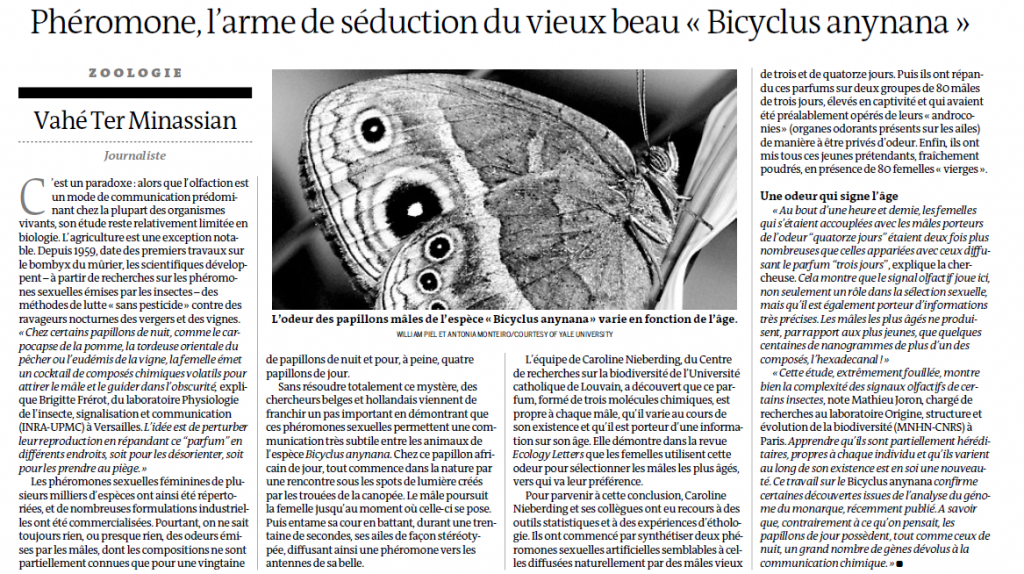
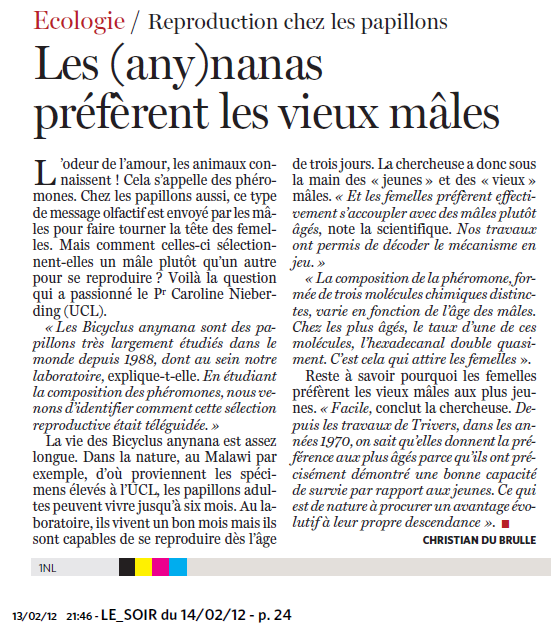
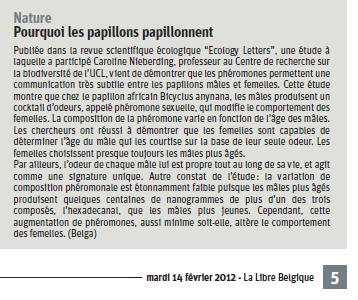
Nieberding CM, Fischer K, Saastamoinen M, Allen C, Wallen E, Hedenström E & Brakefield PM. Cracking the olfactory code of a butterfly: the scent of ageing. Ecology Letters 15: 415–424. PDF
Females use the sex pheromone emitted by courting males to check their age. They also check their level of genetic diversity (see van Bergen et al (2013) PRSL). This publications was scored by Gabriele Sorci, a Member of the Faculty of 1000 (F1000), as a “must read” in the top 2% of published articles in biology and medicine in 2012.
2011
Bitume EV, Bonte D, Magalhaes S, Van Dongen S, San Martin, G, Olivieri I & Nieberding CM. Heritability and artificial selection on ambulatory dispersal in Tetranychus urticae. PLoS ONE 6(10): e26927. PDF
Here we attempted, but failed, to get dispersal evolve, but we found out how natural selection affects dispersal. Check out Bitume et al (2013) Ecology Letters from our lab to know more.
San Martin G, Bacquet P & Nieberding CM. Mate choice and sexual selection in a model butterfly species, Bicyclus anynana: state of the art. Proc. Neth. Entomol. Soc. Meet. 22: 9-22. PDF
We summarize what was known until 2011 about male secondary sexual traits and female sexual preferences in this model butterfly. Now you need to add a large number of studies and male courtship activity as a fourth male trait under sexual selection.
2010
Callejón R, de Rojas M, Nieberding CM, Foronda P, Feliú C, Guevara D & Cutillas C. Molecular evolution of Trichuris muris isolated from different Muridae hosts in Europe. Parasitology Research, 107: 631-641. PDF
Nieberding CM, Jousselin E & Desdevises Y. 2010. The use of co-phylogeographic patterns to predict the nature of interactions, and vice-versa. In: The geography of host-parasite interactions. S. Morand and B. Krasnov Eds, Oxford Univ. Press, 287 p. pp. 59-69. PDF
2008
Nieberding CM, Schneider MV, de Vos H, Lassance JM, Estramil N, Andersson J, BångJ, Hedenström E, Lofstedt C & Brakefield PM. Male sex pheromones in the butterfly Bicyclus anynana: towards an evolutionary analysis. PLoS ONE 3(7):e2751. PDF
We identified for the first butterfly to date (of which there are 18,000 species worldwide) the composition of the sex pheromone that males emit when courting females. We use a combination of behavioural and chemistry methods to validate that there are three active components, two of which are derived from fatty acids as in the moth ancestors of butterflies.
Nieberding CM, Durette-Desset MC, Libois R, Vanderpoorten A, Deffontaine V, Feliu C, Morand S & Michaux JR. Geography and host biogeography matter for understanding the phylogeography of a parasite. Molecular Phylogenetics and Evolution 47: 538-554. PDF
A parasite needs to track its host to survive and this molds the genetic structure of parasites over millions of years. We showed how parasites can thus be used to track the evolutionary history of their hosts. Curious? Check out Nieberding and Olivieri (2007) in Trends Ecol Evol to know more.
2007
Nieberding CM & Olivieri I. Parasites: proxies for host history and ecology? Trends in Ecology and Evolution 22: 156-165. PDF
We reviewed whether and under which ecological conditions parasites track the evolutionary history of their hosts. This is useful when the host displays little genetic structure itself (as humans in the pre-genomic era) or when hosts are endangered species. Working with Isabelle Olivieri was life changing, for the better.
2006-2001
Nieberding CM, Libois, Morand S & Michaux JR. 2006. Parasites and the insular syndrome: the colonisation of the western Mediterranean islands by Heligmosomoides polygyrus (Dujardin, 1845). Journal of Biogeography 33: 1212-1222. PDF
We showed for the first time that parasites too evolve aspects of the typical insular syndrome when isolated on islands.
Nieberding CM & Morand S. 2006. Comparative phylogeography: the use of parasites for insights into host history. In Micromammals and macroparasites: from evolutionary ecology to management. S. Morand, B. R. Krasnov and R. Poulin Eds, Springer Editions, 637 pages. pp. 277-293. PDF
Deffontaine V, Libois R,Kotlík P, Sommer R, Nieberding CM, Searle JB & Michaux JR. 2005. Beyond the Mediterranean Peninsulas: Evidence of Central European glacial refuges for a temperate forest mammal species, the bank vole (Clethrionomys glareolus). Molecular Ecology 14: 1727-1739. PDF
Nieberding CM, Libois R, Morand S, Douady C & Michaux JR. 2005. Phylogeography of a Nematode (Heligmosomoides polygyrus) in the Western Palearctic region: persistence of Northern cryptic populations during ice ages? Molecular Ecology 14: 765-777. PDF
We found multiple genetic lineages in a parasite, suggesting that it did not follow the evolutionary history of a single host rodent over the last millions years and may have survived on other hosts in the northern and eastern parts of Europe. It also suggests that some temperate species found suitable habitats in northern Europe when the climate was much colder then nowadays.
Nieberding CM, Morand S, Libois R & Michaux JR. 2004. A parasite reveals cryptic phylogeographic history of its host. Proceedings of the Royal Society of London B 271: 2559-2568. PDF
Here we provide the proof of concept that the genetic structure of a parasite can play the role of a biological magnifying glass to find out previously undetected genetic differentiation events of its host. Curious? Check out the review from our lab in Nieberding and Olivieri (2007) Trends Ecol Evol.
Michaux JR, Magnanou E,Paradis E, NieberdingCM & Libois R. 2003. Mitochondrial phylogeography of the woodmouse (Apodemus sylvaticus) in the western Palearctic region. Molecular Ecology 12: 685-693. PDF
